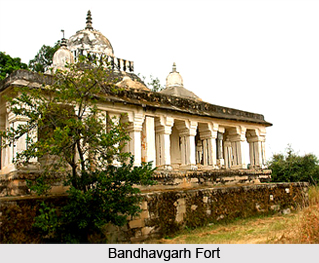 Bandhavgarh Fort is located in Bandhavgarh in the district Umaria of Madhya Pradesh, India. The fort situated on the Bandhavgarh hill, at an elevation of 811 m, above sea level, and is at the centre of the Bandhavgarh National Park (Bandhavgarh Tiger Reserve). The fort is isolated by smoothly sloping valleys and is enclosed by a large number of smaller hills. According to experts, Bandhavgarh Fort was supposedly built around 2000 years ago, however no concrete evidence of its construction have been obtained. Several royal dynasties have controlled the ancient fort of Bandhavgarh, as they have ruled over the kingdom of Bandhavgarh. Various myths state that Lord Rama built the fort for Lakshmana to look over Lanka. Bandhavgarh literally means Brother`s Fort, (Bandhav means Brother and Garh means Fort). Various endangered species of Indian Vultures are also found in this region.
Bandhavgarh Fort is located in Bandhavgarh in the district Umaria of Madhya Pradesh, India. The fort situated on the Bandhavgarh hill, at an elevation of 811 m, above sea level, and is at the centre of the Bandhavgarh National Park (Bandhavgarh Tiger Reserve). The fort is isolated by smoothly sloping valleys and is enclosed by a large number of smaller hills. According to experts, Bandhavgarh Fort was supposedly built around 2000 years ago, however no concrete evidence of its construction have been obtained. Several royal dynasties have controlled the ancient fort of Bandhavgarh, as they have ruled over the kingdom of Bandhavgarh. Various myths state that Lord Rama built the fort for Lakshmana to look over Lanka. Bandhavgarh literally means Brother`s Fort, (Bandhav means Brother and Garh means Fort). Various endangered species of Indian Vultures are also found in this region.
Mythological Origin of Bandhavgarh Fort
According to references obtained from ancient books, like Narad-Panch Ratra and Shiva Purana, Bandhavgarh fort was constructed approximately 2000 years ago. According to Hindu mythology, Lord Rama, while returning to Ayodha after defeating the demon King Ravana, ruler of Lanka, built the fort Lakshmana, his younger brother, to look over Lanka and left him in charge. Hence the name Bandhavgarh, which means Brother`s Fort, was given to the fort. Since then, Lakshmana was worshipped in this region in the name of Bandhavdhish.
History of Bandhavgarh Fort
As per local legends, Bandhavgarh fort was built by rulers of Gond Empire of Pandro cast. The Gond kings have created 12 Talab ponds, of which only a few remain. The architecture of the fort has close resemblance with other Gond structures. Many dynasties like Mauryans in 3rd century BC, Vakataka rulers from 3rd-5th century, Sengars in 5th century, have conquered and controlled the fort during their reigns. The Kalachuris ruled over Bandhavgarh fort from 10th century. After that, in the 13th century, the Baghels conquered over Bandhavgarh and ruled until 1617, when Maharaja Vikramaditya Singh shifted his capital to Rewa. Bandhavgarh fort was finally abandoned by the last residents in 1935.
Architecture of Bandhavgarh Fort
There are few sculptures that depict the various avatars of Lord Vishnu, like Matsya, Narasimha, Varaha and Kurma avatar. There are a couple of ponds on the hill as well such as Rani Talab. Another enormous statuette of Vishnu, in a lying posture, which is known as Seshsaiyan is also found in Bandhavgarh fort. Moreover a number of caves are also located in the fort that date back to 1st century BC. Brahmi inscriptions adorn the walls of these caves.
The breathtaking Bandhavgarh National Park is located near the fort, which is also a prime tourist attraction of this region. The travellers can also visit Kalchuri Archaeological museum where various historical and archeological findings can be viewed. Bandhavgarh fort is located 164 km from Jabalpur and local buses are available for the tourists to reach the national park. Katni is the nearest station at a distance of 120 km and this railway junction the region with the rest of the country.



















